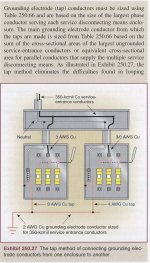slc410
Electrician
- Location
- Madison wi
- Occupation
- Electrician
We have a situation where we have a 400 amp service on a commercial building which is a ct cabinet on the exterior and two 200 amp main disconnect panels on the interior fed parallel each with feeders from the ct cabinet. Does the grounding electrode conductor have to run continuous from the rods through the first panel and then to the second or can it land on the ground bar in the first then another wire from that same bar to the second?


